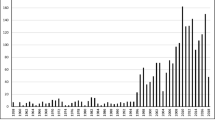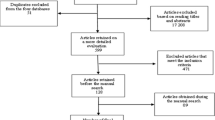Abstract
Innovation and new ideas often arise in contexts that are more conducive to the recombination of existing knowledge. I use data from hip hop chart rankings and YouTube video views to uncover patterns of this recombination and measure their impact in a cultural setting. This genre of music is used because, more than others, it has the custom of explicitly featuring guest artists and samples of existing songs. These processes provide a quantifiable measure of the extent of recombination of existing knowledge in the new songs’ creative process. I find that songs that more explicitly rely on recombination have greater impact. The results suggest that the more successful songs include not just novelty, but novelty together with elements of conventionality. This is in line with other analyses of innovation and impact in other creative industries. The propensity for recombinant strategies to uncover valuable innovation depends on the geographic, institutional, cultural and network structures where this search takes place. Hip hop music, through its explicit use of features and samples, illustrates some characteristics of successful recombinant innovation that can be extended to other genres and creative industries.


Similar content being viewed by others
Data availability
The dataset used in this paper is available upon request.
Notes
Thus, a song that entered in 2015 but was still in the charts in 2016 is included, as well as songs that entered in 2016 but only left in 2017. This makes a sample of 463 songs. The chart lists the top 50 songs each week as calculated by Billboard. https://www.billboard.com/charts/r-b-hip-hop-songs
The sampling data is from https://www.whosampled.com/ a online site that crowdsources the search of samples to “Explore the DNA of music”.
The collaboration between RUN-DMC and Aerosmith re-recoding the latter’s hit ‘Walk This Way’ with a rap feel is often held as the defining moment when rap started to grow beyond its traditional fan base (Rose 1994: loc 1612). This is another example of how recombination of existing information can have special impact. From the point of view of mainstream markets it was a combination of something safe and conventional with something new and risqué.
See for example https://djbooth.net/features/2016-02-24-rappers-guest-verse-trade.
The three lone thinkers are “first-century Confucian metaphysicist Wang Chung, 14th-century Zen spiritualist Bassui Tokusho, and fourteenth century Arabic philosopher Ibn Khaldun” Uzzi and Spiro (2005: 448).
If most songs in the sample were one-hit wonders, this variable could be endogenous, as the number of followers on Spotify would be determined by that song’s success. Almost the totality of artists in the sample had long careers (average year started = 2005) and several hits.
Table 3 in the appendix shows descriptive statistics.
It may seem odd that Canadian Rap is a major genre. This is because two Canadian rap artists, Drake and The Weeknd hold 70 of the 463 songs that made it to the Billboard Hip Hop / R&B charts in 2016.
References
Arthur B (2009) The nature of technology: what it is and how it evolves. Simon and Schuster
Alcaide-Marzal J, Tortajada-Esparza E (2007) Innovation assessment in traditional industries. A proposal of aesthetic innovation indicators. Scientometrics 72(1):33–57
Askin N, Mauskapf M (2017) What Makes Popular Culture Popular? Product Features and Optimal Differentiation in Music. Am Sociol Rev 82(5):910–944
Barabási AL (2018) The Formula: The Universal Laws of Success. Hachette UK
Barron ATJ, Huang J, Spang RL, DeDeo S (2018) Individuals, institutions, and innovation in the debates of the French Revolution. Proc Natl Acad Sci. https://doi.org/10.1073/pnas.1717729115
Basalla G (1988) The evolution of technology. Cambridge University Press, Cambridge
Beinhocker ED (2006) The origin of wealth: evolution, complexity, and the radical remaking of economics. Harvard Business Press
Boyd R, Richerson PJ (2005) The Origins and Evolution of Culture. IL, University of Chicago Press, Chicago
Cattani G, Ferriani S, Colucci M (2015) Creativity in social networks. In the Oxford handbook of creative industries. Oxford University Press, Oxford, p 75
Darwin CR (1871) The descent of man and selection in relation to sex. John Murray, London
Fagerberg J (2003) Schumpeter and the revival of evolutionary economics: an appraisal of the literature. J Evol Econ 13(2):125–159
Frieler K, Jakubowski K, Mullensiefen D (2015) “Is it the Song and not the Singer? Hit Song Prediction Using Structural Features of Melodies.” In Yearbook of Music Psychology (Jahrbuch Musikpsychologie). Auhagen, W., Bullerjahn, C. & von Georgi, R. Hogrefe. 25.
Haampland O (2017) Power laws and market shares: cumulative advantage and the Billboard Hot 100. J New Music Res 46(4):356–380
Hargadon A, Sutton RI (1997) Technology brokering and innovation in a product development firm. Adm Sci Q 42:716–749
Henrich J (2016) The secret of our success: how culture is driving human evolution, domesticating our species and making us smarter. Princeton University Press, Princeton
Henrich J (2020) The weirdest people in the world: How the west became psychologically peculiar and particularly prosperous. Farrar, Straus and Giroux
Hidalgo C, Hausmann R (2009) The Building Blocks of Economic Complexity. Proc Natl Acad Sci USA 106(26):10570–10575
Jacobs J (1961) The Death and Life of Great American Cities. Vintage Books, New York
Johnson S (2010) Where Good Ideas Come From: The Natural History of Innovation. Penguin Group, New York
Jones BF (2021) The Rise of Research Teams: Benefits and Costs in Economics. J Econ Perspect 35(2):191–216
Kaplan P (2017) “The rise of ‘feat.’ in today’s music.” Distrokid News’n Stuff. March 9, 2017. https://news.distrokid.com/the-rise-of-collaborations-in-todays-music-8a8bcd386ea. Accessed 15 May 2022
Kauffman SA (1993) The Origins of Order: Self-organization and Selection in Evolution. Oxford University Press, USA
Klement B, Strambach S (2019) How do new music genres emerge? Diversification processes in symbolic knowledge bases. Reg Stud 53(10):1447–1458
Kuhn TS (1970) The structure of scientific revolutions, vol 111. University of Chicago Press, Chicago
Lena JC (2004) “Meaning and membership: samples in rap music”, 1979–1995. Poetics 32(3–4):297–310
Lena JC, Peterson RA (2008) Classification as culture: Types and trajectories of music genres. Am Sociol Rev 73(5):697–718
Mesoudi A (2011) Cultural Evolution. University of Chicago Press, Chicago
Mokyr J (2011) The gifts of athena: historical origins of the knowledge economy. Princeton University Press, Princeton
Mokyr J (2018) A culture of growth: the origins of the modern economy. Princeton University Press, Princeton
Muthukrishna M, Henrich J (2016) Innovation in the collective brain. Phil Trans R Soc B 371(1690)
Mueller B (2021) Where’d you get that idea? Determinants of creativity and impact in popular music. Economia 22(1):38–52
Nelson RR, Winter SG (1982) An Evolutionary Theory of Economic Change. Harvard University Press, Cambridge
OECD/Eurostat (2018) Oslo Manual 2018:Guidelines for Collecting, Reporting and Using Data on Innovation, 4th Edition, The Measurement of Scientific, Technological and Innovation Activities, OECD Publishing, Paris/Eurostat, Luxembourg
Pachet F, Roy P (2008) Hit song science is not yet a science. Proc of Ismir ‘08, Philadelphia, pp 355–360
Phillips Y (2016) Inside the hidden world of rappers trading guest verses. DJBooth. https://djbooth.net/features/2016-02-24-rappers-guest-verse-trade. Accessed 15 May 2022
Poincaré H (1908/1982) “Science and method”. In H. Poincaré (Ed.), The Foundations of Science (p. 359–547). Washington, DC: University Press of America
Potts J (2019) Innovation commons: the origin of economic growth. Oxford University Press, Oxford
Romer PM (2019) Nobel lecture: on the possibility of progress. https://paulromer.net/prize/. Accessed 15 May 2022
Rose T (1994) Black noise: Rap music and black culture in contemporary America, vol 6. Wesleyan University Press, Hanover, NH
Sapsed J, Tschang FT (2014) Art is long, innovation is short: Lessons from the Renaissance and the digital age. Technol Forecast Soc Chang 83:127–141
Schlaile, M.P., Veit, W., and Boudry, M. (2022). “Memes”. In K. Dopfer, R. R. Nelson, J. Potts, and A. Pyka (Eds), Routhledge Handbook of Evolutionary Economics, London: Routledge.
Schumpeter JA (1934) The theory of economic development. Harvard University Press, Cambridge
Schumpeter JA (1947) The creative response in economic history. J Econ Hist 7(2):149–159
Salganik MJ, Dodds PS, Watts DJ (2006) Experimental study of inequality and unpredictability in an artificial cultural market. Science 311:854–856
Salganik MJ, Watts DJ (2008) Leading the herd astray: an experimental study of self-fulfilling prophecies in an artificial cultural market. Soc Psychol Q 71(4):338–355. https://doi.org/10.1177/019027250807100404
Stoneman P (2010) Soft innovation: economics, product aesthetics, and the creative industries. Oxford University Press, Oxford
Thompson D (2017) Hit makers: the science of popularity in an age of distraction. Penguin Books
Uzzi B, Mukherjee S, Stringer M, Jones B (2013) Atypical Combinations and Scientific Impact. Science 342:468–472
Uzzi B, Spiro J (2005) Collaboration and creativity: the small world problem. Am J Sociol 111(2):447–504
Weitzman ML (1998) Recombinant Growth. Quart J Econ 113(2):331–360
West G (2017) Scale: the universal laws of growth, innovation, sustainability, and the pace of life in organisms, cities, economies, and companies. Penguin Books
Wuchty S, Jones BJ, Uzzi B (2007) The Increasing Dominance of Teams in Production of Knowledge. Science 316:1036–1039
Youn H, Strumsky D, Bettencourt LMA, Lobo J (2015) Invention as a combinatorial process: evidence from US patents. J R Soc Interface, 12(106). https://doi.org/10.1098/rsif.2015.0272
Author information
Authors and Affiliations
Corresponding author
Ethics declarations
Conflict of interest
The author declares that he has no conflict.
Additional information
Publisher’s note
Springer Nature remains neutral with regard to jurisdictional claims in published maps and institutional affiliations.
Appendix
Appendix
Rights and permissions
About this article
Cite this article
Mueller, B. Recombination for innovation and market impact: Samples and features in hip hop music. J Evol Econ 32, 929–953 (2022). https://doi.org/10.1007/s00191-022-00771-w
Accepted:
Published:
Issue Date:
DOI: https://doi.org/10.1007/s00191-022-00771-w




